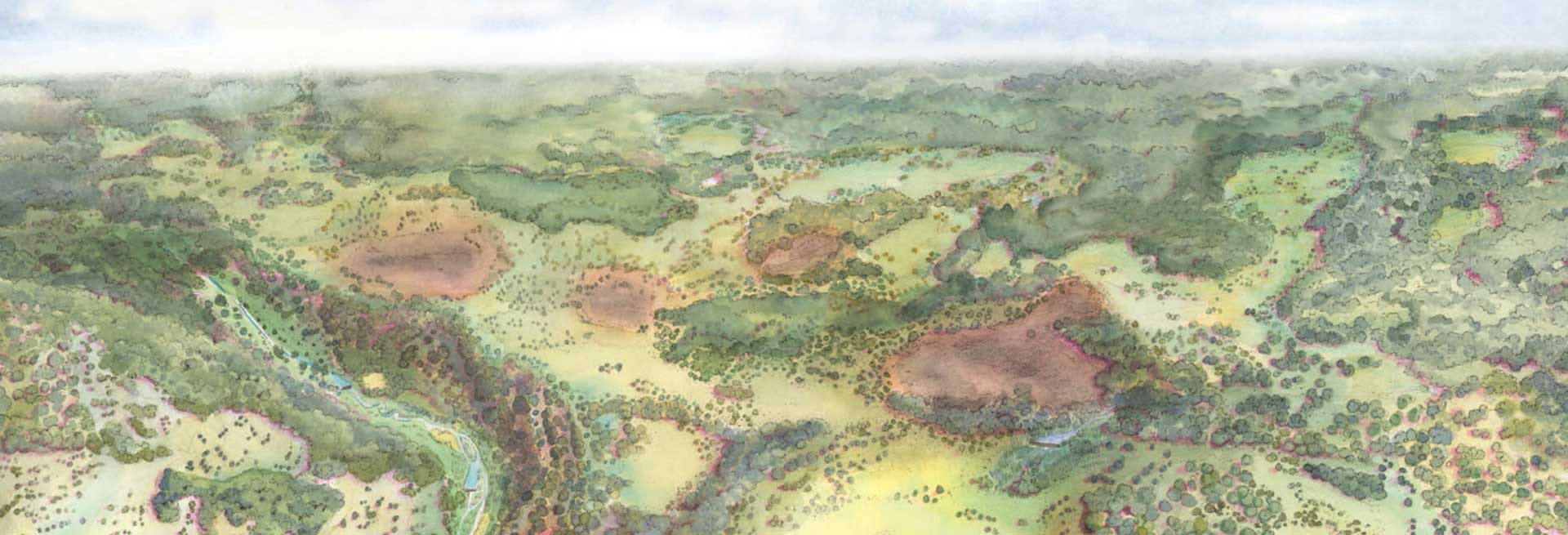
Sapperton's Wilder Past - 7000 Years Ago
Natural Processes
The diversity of natural ecosystems helps them to be resilient and self-sustaining. Understanding how natural processes; the water and mineral cycles, energy flows and community dynamics, work in natural ecosystems can guide decisions about how to both restore nature and farm sustainably.
In lowland England there are no ecosystems unaltered by human intervention to use as a benchmark. However, analysis of pollen and insect remains from the late Mesolithic period (9000-7000 years ago) gives us an impression of what our pre farmed landscape and wildlife was like. During this time humans lived in small groups, migrated across the landscape hunting deer, auroch and wild boar and gathering nuts, berries, roots and leaves.
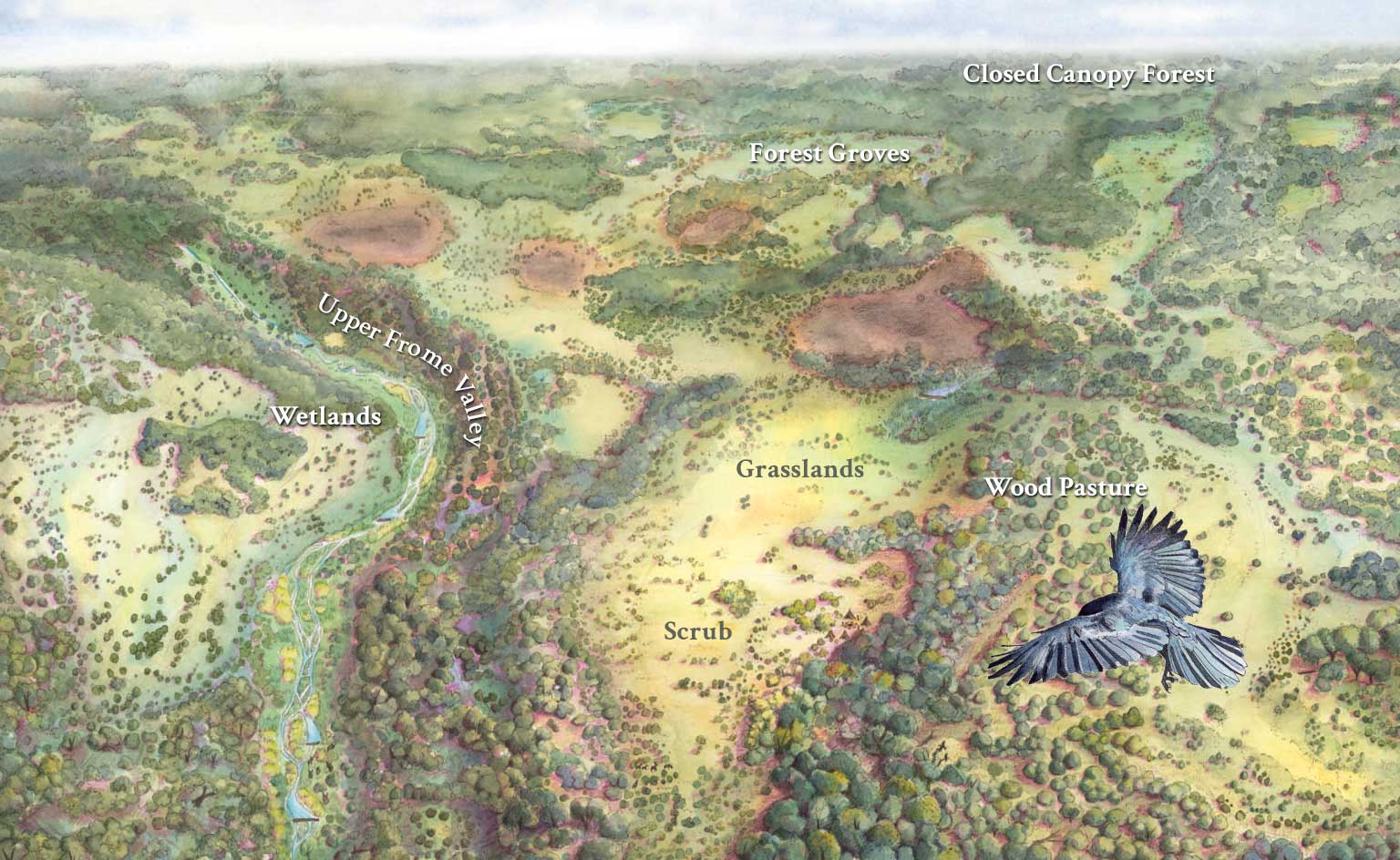
Mosaic Habitat
Plants started to re-colonised after the glaciers retreated from England 12,000 years ago. First tundra with scrub willow, then pine and birch, creating a landscape like Scandinavia today. By 8,000 years ago these were replaced by oak, hazel, elm, lime and alder. The primeval forests contained enormous and ancient trees and an abundance of deadwood.
It used to be thought that the wildwood had a closed canopy and covered most of Britain, but analysis of beetles and pollen remains has revealed a landscape of wood pasture, open grassland, wetland, regenerating scrub and forest groves, grazed by herds of large herbivores.
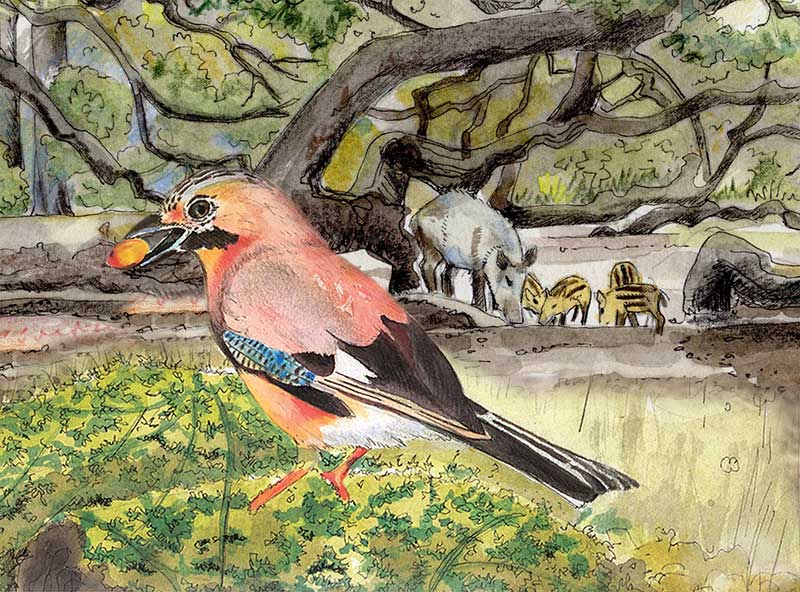
Jays save acorns for winter by burying them, but fail to retrieve them all thus accelerating the migration of oak trees.
The rootling of wild boar provided bare ground for the jays to hide the acorns; without their help oak trees may not have arrived before rising sea levels cut Britain off from the rest of continental Europe 6,500 years ago.
Energy Flow And Nutrient Cycling
The fundamental process sustaining most life on earth is photosynthesis; the capturing of energy in sunlight by plants to power the conversion of carbon dioxide and water into simple carbohydrates and oxygen. Some of the carbohydrates are used by plants for their own growth but most of it is secreted into the soil via roots to feed soil microorganisms. In exchange mycorrhizal fungi transport nutrients to the plant along a dense network of long thin filaments called hyphae. Grazing stimulates plants to secrete more carbohydrates into the soil which helps to build deep and fertile topsoil.
Fungi produce a glue-like substance, called glomalin, which sticks soil particles together, creating aggregates separated by voids. The voids provide refuge for soil microorganisms, aeration and a surface for water retention. By decomposing organic matter soil microorganisms play a role in the production of humus, an important component of healthy soil, providing plant nutrients and good water holding capacity. Some plants and soil bacteria fix atmospheric nitrogen into the soil, making it available for plant growth and the ecosystems they sustain.
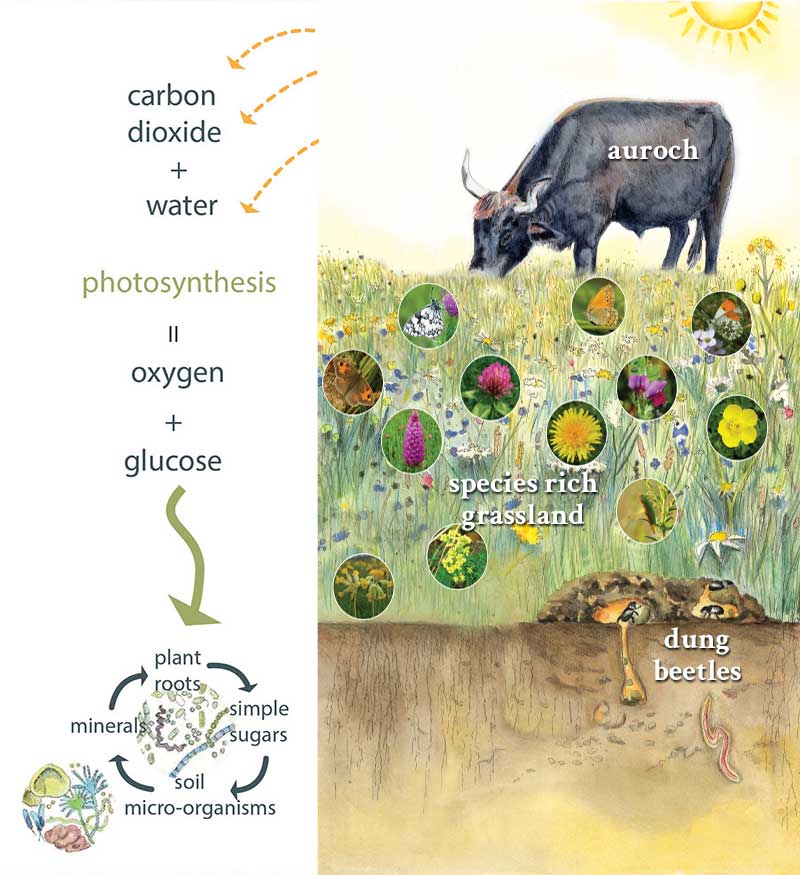
Ecosystem Dynamics
Browsing and Grazing
By eating and knocking down saplings and stripping bark from trees herbivores kept areas of grassland open. Woodland glades are one of the most important habitats for wildlife with a high diversity of associated plant and animal species. Herds of herbivores would have kept moving in search of fresh growth and to avoid predators, giving grassland plants time to recover.
Charcoal evidence shows that repeated deliberate burning of vegetation took place in Gloucestershire during the late Mesolithic. Firing was done to provide open grassland. This made hunting easier and increased the growth of grasses, wildflowers and woodland edge shrubs, which created enhanced grazing for large herbivores, including red deer, roe deer and aurochs which were wild cattle and are now extinct. Areas cleared by fire were colonised by plants edible to humans, including hazel and bramble. The rootling of wild boar also contributed to the establishment of thorny scrub by providing bare soil for tree and shrub seeds to germinate.
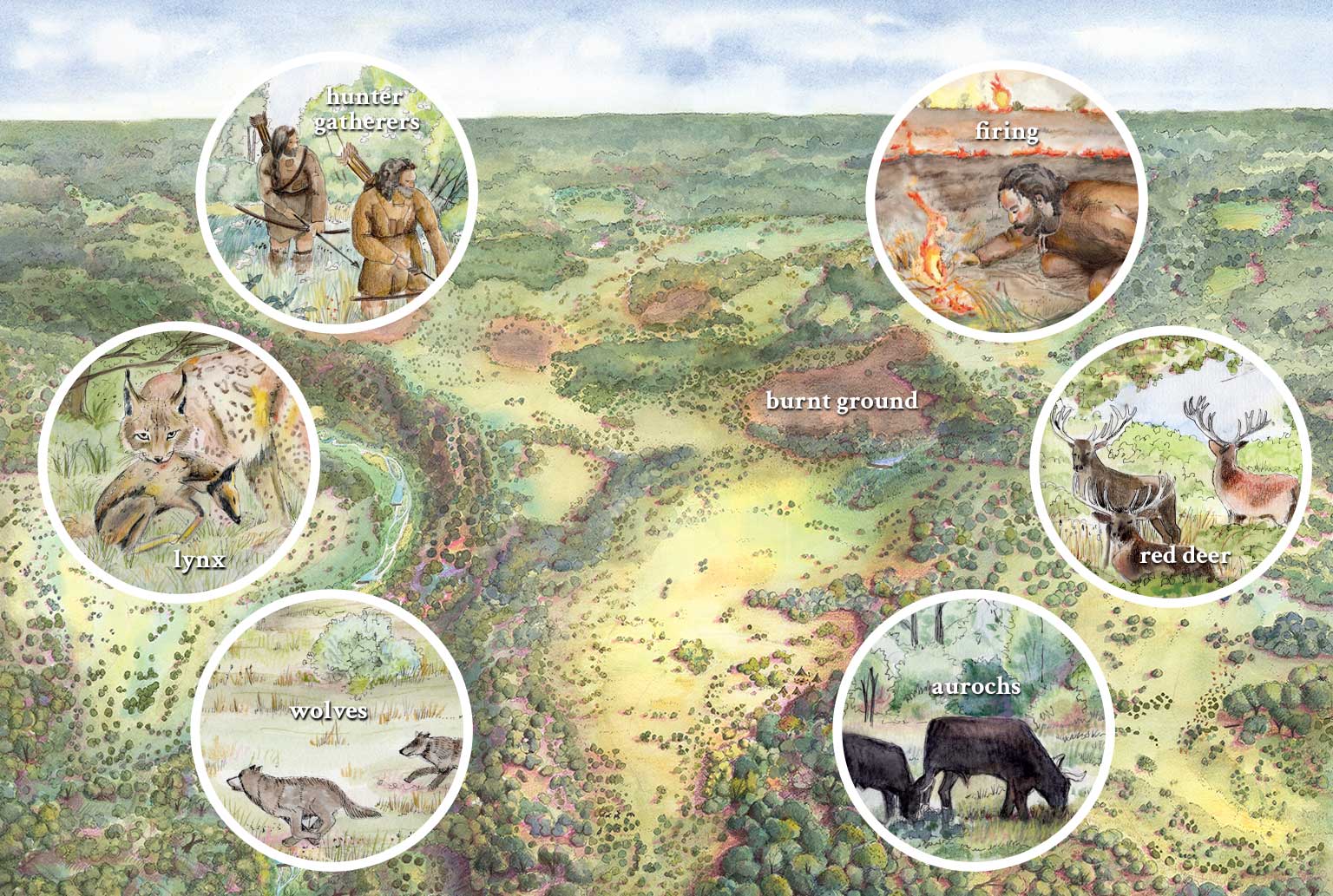
Hunting
If herbivores graze and browse unchecked there is a risk that no trees or shrubs would grow which would be detrimental to the many species which require scrub, trees and deadwood.
Hunter gatherers shared the landscape with large predators, including wolves, bears, eagles and lynx, and smaller ones including wild cats and pine martens. Predators, especially pack animals like wolves, modify the behaviour of grazing animals. Areas with low visibility or barriers to escape, such as rivers, would have been avoided, allowing scrub and woodland to become established.
The interactions between herbivores, predators and humans maintained a mosaic of habitats with an inherently high biodiversity. This helped the natural ecosystem to be resilient to events such as extreme weather or new species colonising.
Healthy Water Cycle
Water moved slowly through the natural ecosystem and would have moved between the atmosphere, vegetation, soil and water courses many times on its journey to the sea. The deep soil with good crumb structure would have enabled rapid water infiltration after storms and stored ample water for drier periods, helping to prevent flooding and the negative impacts of droughts.

Beaver Wetlands
During the late Mesolithic period beavers would have lived in the upper catchment of the Frome Valley, creating dynamic wetlands, mosaics of wet woods, beaver meadows, pools and coppice. By increasing the depth of the river their dams caused the channel to divide and meander, spreading out over a wide area.
Beavers co-evolved with other wetland species over millennia, and their wetlands would have supported a huge diversity of plants, invertebrates, fish, amphibians, birds, reptiles and mammals. Many native trees, such as willow, respond to being felled by beavers by coppicing helping to maintain more open areas along the river valley.
The preferred habitat of aurochs was wetlands and floodplains; by trampling and browsing they helped keep the valley bottom clear of woody vegetation.

Sapperton's Recent Past
Loss Of Habitat
Farming began in the Cotswolds about 7000 years ago, and by the Iron Age, 3000 years ago, most of the land was cultivated or grazed by livestock. Traditional farm practices, such as mixed arable and livestock farming and the maintenance of meadows and coppice, were aligned with natural processes and helped to maintain biodiversity, deep soil and healthy hydrology.
Since the 1940’s farming developed in a way increasingly at odds with natural processes, focusing on high yields at the expense of a healthy farm ecosystems. The intensification of farming was motivated by the need to increase food production during the Second World War and then to support economic recovery after the war.
In Britain 70% of the land is used for agriculture and its intensification has resulted in the loss of natural habitat and wildlife. The 2023 State of Nature report, produced by the United Nations and World Wildlife Find, found that 53% of UK species had shown a strong decline since the previous decade. The principal causes of this decline are a move from spring to autumn sowing of arable crops which increased use of fertiliser and pesticides, larger farm machinery resulting in deeper ploughing and more compaction, a switch from hay to silage, a decline of combining pastoral with arable farming, and the removal of and intensification of management of hedgerows.
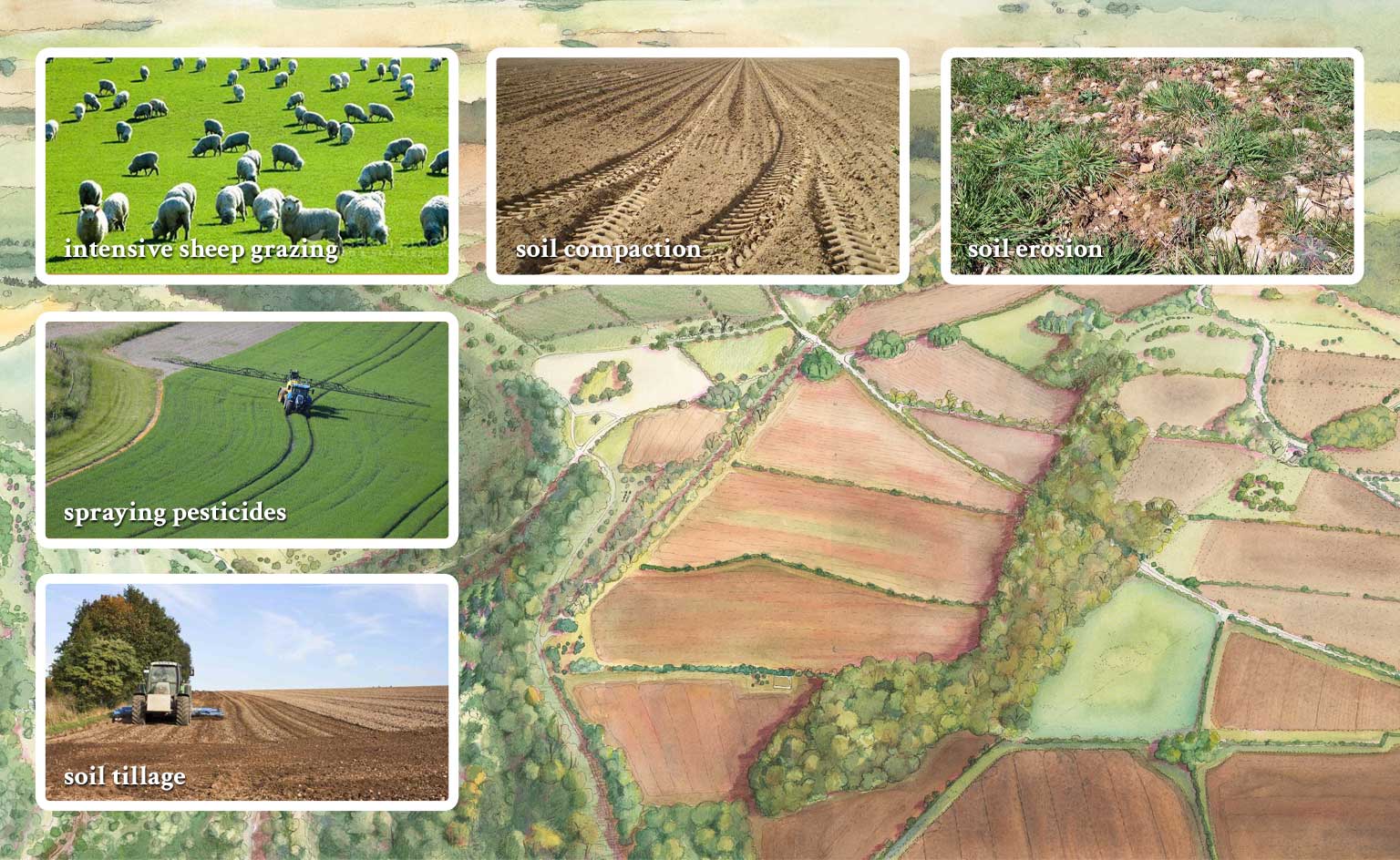
Nutrient Cycle And Energy Flows
At Sapperton Wilder there is little top soil left, many intensive farming practices are detrimental to soil health and nutrient cycling;
- Ploughing and other forms of cultivation damages soil structure, through compaction and breaking up the fungal networks, resulting in reduced water infiltration and storage;
- Single species crops excrete the same root exudates, at the same time and at the same soil depth, which reduces the diversity of soil organisms;
- Supplying plants with artificial fertilisers causes them to stop supplying soil organisms with carbohydrates, resulting in a loss of their diversity and abundance and soil enhancing actions;
- Reduction of soil fungi results in loss of soil binding glomalin and consequently a reduction of soil porosity, aeration, water infiltration and storage capacity;
- Opening the soil to oxygen allows aerobic bacteria to break down the glomalin and humus, the resulting voids are filled with silt and clay, resulting in less space for nitrogen fixing bacteria;
- Leaving the soil bare results in erosion from wind and rain and higher evaporation and temperature rates in hot weather resulting in less water availability, and problems with weeds.
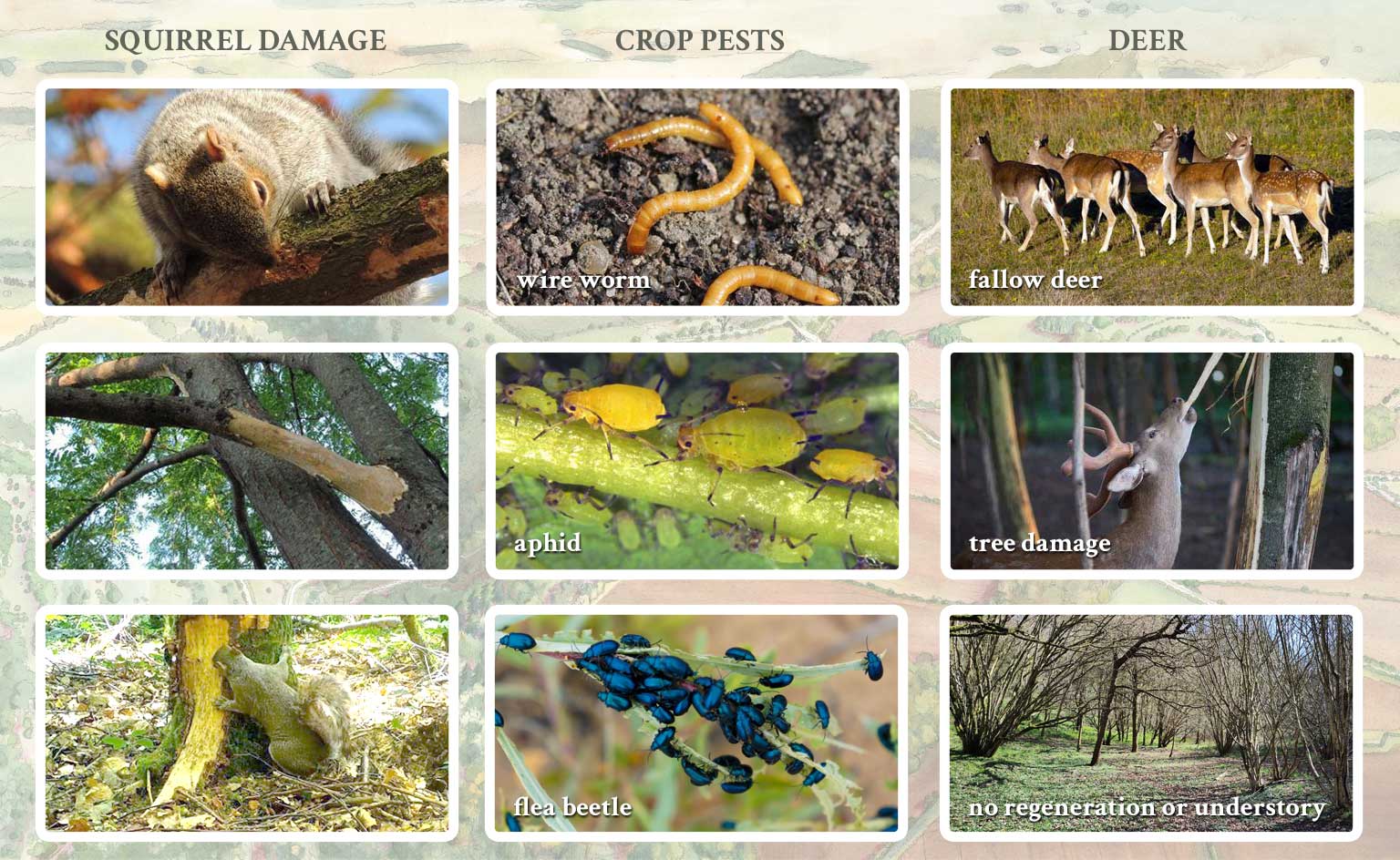
Ecosystem Imbalance
Predators
Large predators, like wolves and lynx, were lost from the ecosystem through hunting and habitat loss resulting in no natural predators for deer. Their numbers used to be kept in check by farmers who were more numerous and present on the land. A Deer Activity and Woodland Impact Assessment at Sapperton Wilder found high fallow deer numbers and significant damage to woodland.
Squirrel number have also increased due to the loss of smaller predators, such as wild cats and pine martens, and also cause significant damage to woodland trees.
Pest Predators
Agriculture policies during the 20th Century paid farmers to remove hedgerows. Remaining hedgerows were often cut annually and because most shrubs flower on two-year-old growth this resulted in significantly fewer flowers and berries the following year. Combined with narrow field margins and the use of pesticides this caused a reduction of predator species, such as ladybirds, to keep crop pests under control. This resulted in an upward spiral of infestations and pesticide applications and resistance to some insecticides. The use of pesticides reduces the numbers of insects available to birds and other wildlife for food.
Fortunately, when the Sapperton Wilder project began in the early 2020’s the hedges were relatively intact, and work began planting up any gaps.

Droughts And Floods
Soil
Floods and droughts have a common cause. Soil compaction caused by heavy farm machinery and degraded soil structure, due to loss of soil micro-organisms, reduces the rate of water infiltration and water storge capacity. This results in an increased amount of overland runoff, causing both soil erosion and increased risk of flooding. Compaction and damage to soil structure also results in less water being stored, resulting in less resilience to drought conditions.
Beavers
Beavers were hunted to extinction in Britain 400 years ago. The loss of beaver dams and pools resulted in the River Frome flowing faster and cutting a single route through the valley. There is evidence that the River Frome in this upper valley section has been artificially straightened and deepened to help drain the adjacent pastureland.
The increased overland runoff and the speed of water through the river contributes to flooding in villages and towns lower down in the catchment. Between and 2014 and 2018 Stroud District Council installed leaky dams on the River Frome to slow down and store water during storm events. River gauge data suggest the leaky dams in the River Frome’s catchment contribute to a reduction of peak river levels by up to 1m in downstream watercourses.

Sapperton Wilder in 2054
The year is now 2054 and the landscape at Sapperton Wilder is a mosaic of habitats delivering ecological restoration through the framework of regenerative agriculture.
During the 2020’s the focus of agriculture policies shifted from maximising yield to paying farmers to look after natural capital; water, air, soil and biodiversity and to provide of ecosystem services; carbon cycling, healthy hydrology and habitat for beneficial wildlife. Making space for nature and creating a healthy farm ecosystem led to a diversity of income streams from both crops and payment for ecosystem services. The reduction in the inputs of fertilisers and pesticides and cost associated with cultivating the soil in addition to government grants helped maintain a profitable farm while also making space for nature.
An experimental agroforestry plot was planted in 2024, followed by planting up one third of the farm over the next few years. The thirty-meter-wide spaces between the rows are either sown with herbal ley for grazing the herd of long horn cattle or minimum till arable crops. Trees enhance the nutrient status of soils, as well improving nutrient cycling and retention.
The species include local varieties of fruit trees on vigorous rootstocks, walnuts, hazel, almond, and nitrogen fixers; sea buckthorn and alder. Birch, a quick growing species which helps with soil nutrient cycling, was planted, it has already been harvested. The trees and herbal leys have increased the abundance and species richness of wildlife, especially birds and invertebrates.
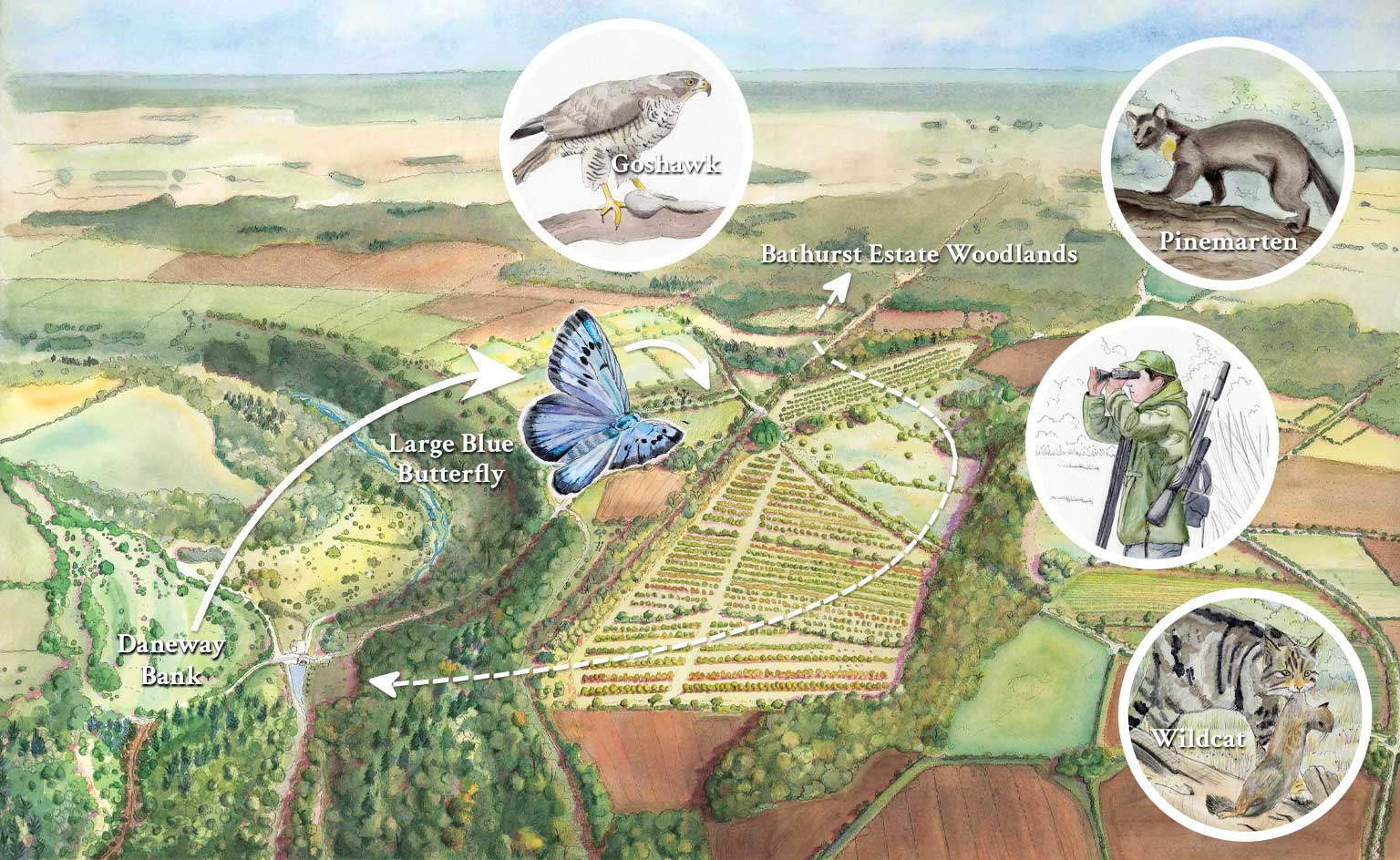
Mosaic Habitat And Connectivity
The rows of trees act as wildlife corridors between the woodland in the Sapperton Valley with woodland on the Bathurst estate which have helped provide enough connected habitat for pine martens and wildcats to be reintroduced. They are now helping to control grey squirrel populations, reducing damage to trees. The number of fallow deer is maintained at a sustainable level through deer stalking, which provides an additional income stream.
The large blue butterfly was reintroduced to the Daneway on the opposite side of the valley in earty 2000's and the grassland at Sapperton Wilder has increased its habitat and connectivity at a landscape scale. It is now well established within the wider area.
Species Rich Grassland
In the mid 2020’s the phosphorus levels were reduced by taking hay cuts, wildflowers were introduced using green hay from local donor sites. Long horn cattle, which are a traditional breed, graze the sward in a way that mimics natural grazing and help to create structure and species diversity within the grassland. The pastures have not been ploughed, and no fertilisers have been applied for over thirty years. The species and structural diversity of the sward is good for wildlife including ground nesting birds and their population numbers are ever increasing.
No cattle treated with medicines for parasites have been onto the site within 48 hours of treatment for thirty years. Consequently, dung ecology is thriving and provides food for wildlife, helps to keep the pasture clean, reducing the number of livestock parasites and improved soil fertility and water infiltration rate.
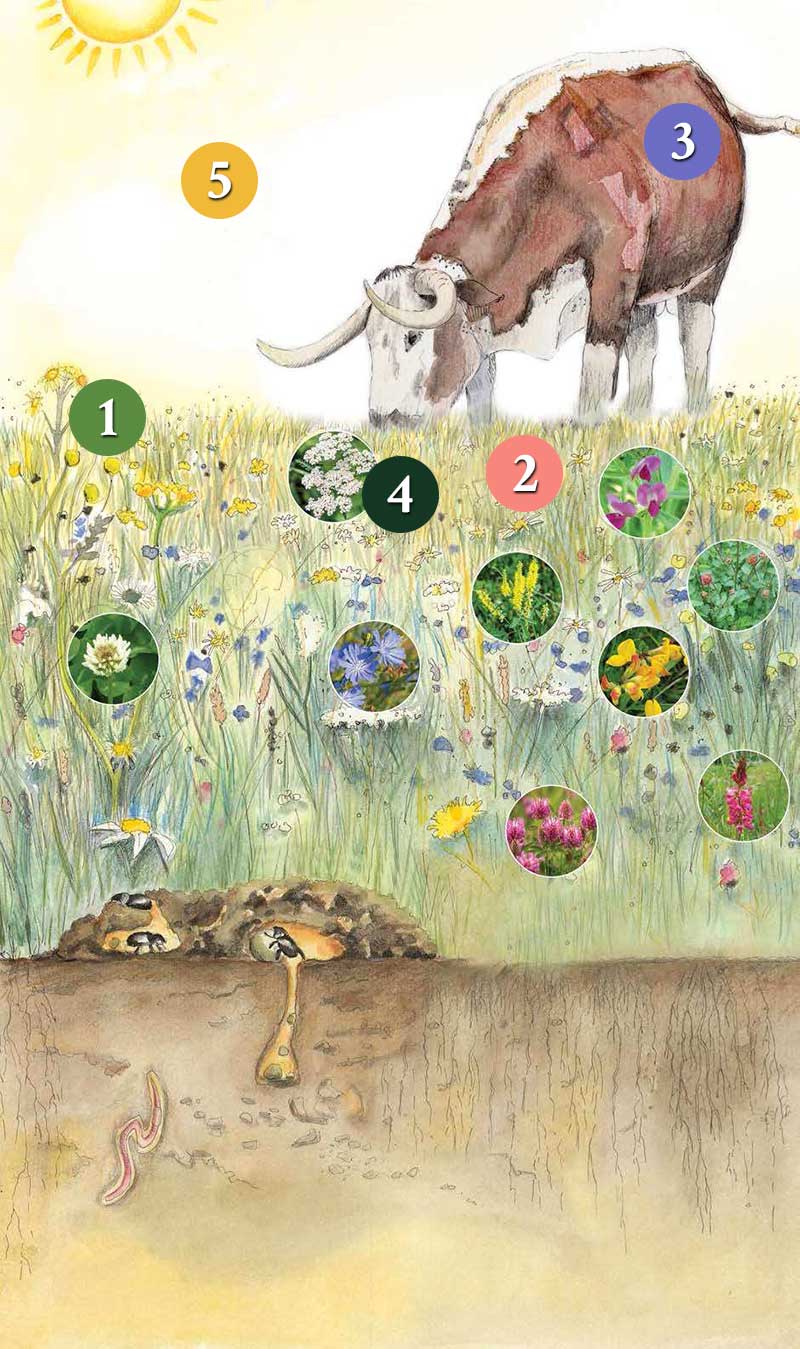
Biogenic Carbon Cycle
- Plants convert carbon dioxide into carbohydrates such as cellulose and starch.
- The cellulose and starch components of the grass are ingested by cattle.
- The bacteria in the cattles's rumen converts some of the cellulose and starch into methane.
- Methane is released from the cow's mouth into the atmosphere.
- After 10 years, methane is converted back to atmospheric carbon through hydroxl-oxidation.
Dung beetles and worms thrive because no pesticides or fertilisers are used.
Nutrient Cycle And Energy Flows
The soil was tested at the start of the project and every five years subsequently. After thirty years of farming regeneratively the soil at Sapperton Wilder is deep, nutrient rich with a good structure.
The five principles of regenerative farming used are;
- Using minimal tillage and minimal chemicals leaving the soil microorganisms intact, enabling them to produce glomalin and humus, providing nutrients and creating a healthy soil structure;
- Keeping the soil covered, inhibits weed growth and soil erosion, and helps keep soil temperatures down during hot weather which reduces evaporation and makes soil moisture more available to plants;
- Diversity above ground increases soil microorganism diversity below ground. Growing a variety of crops and cover crops, including nitrogen fixing species, and using variable crop rotations increases the health of the soil microbial community, and consequent soil health:
- Keeping living roots in the soil, including using cover crops between production crops, results in more photosynthesis and consequently more carbon being sequestered into the soil, resulting in a healthy population of soil organisms resulting in healthy soil;
- Integrating animals, grazing stimulates plants to grow and secrete more carbon into the soil, with a positive effect on nutrient recycling.
Due to climate change precipitation has become more erratic and extreme weather events are more frequent. The improved structure and fertility of the soil has helped to buffer these, helping to maintain healthy crops and livestock, removing the need for inputs of fertiliser and helping to keep the farm profitable.
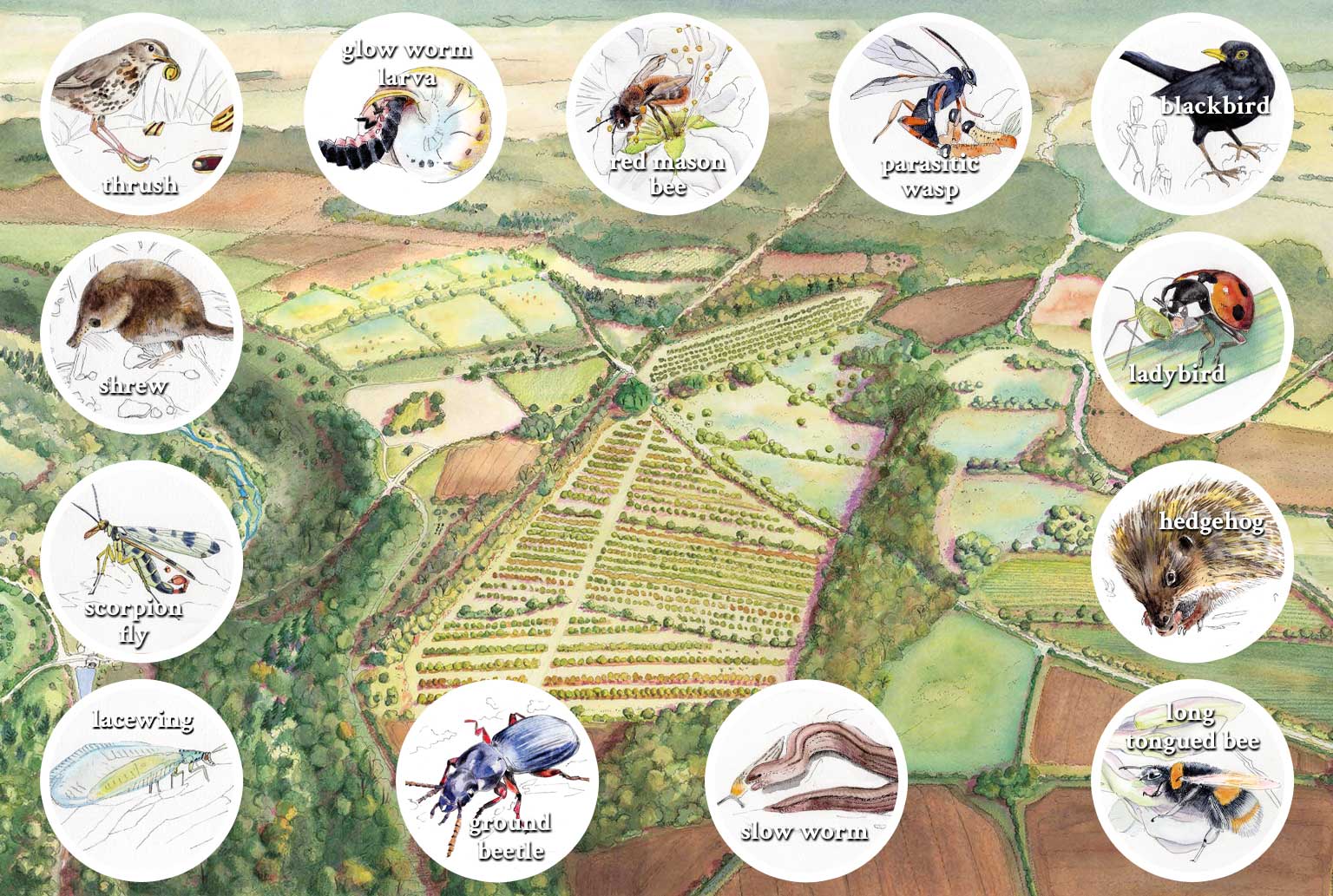
Ecosystem Dynamics
Hedgerows
Hedges have been part of the British landscape for thousands of years and are regarded as remnants of thorny scrub from the pre-farmed landscape. They provide wildlife corridors across the landscape and multiple ecosystem services, including improved hydrology, reduced soil erosion, carbon sequestration, and shelter and shade for livestock.
During the mid-2020 shrubs were planted in gaps in the hedgerow and trees were planted every twenty to thirty metres, these are now well established. The hedges have been allowed to grow wider and taller and are cut on rotation every three years during the winter months. Cutting in late winter allows insects and birds to feed on the flowers and berries and as most species flower and fruit on wood that is two years old this rotation significantly increases the amount of fruit and flowers available to wildlife.
Wide buffer strips are left uncut and uncultivated either side of the hedges. The hedges and buffer strips provide habitat for invertebrates, birds, reptiles and mammals, some help pollinate crops and many are pest predators that keep crop pests under control. This both reduces the need for insecticides and increases crop yields and as a consequence profitability.
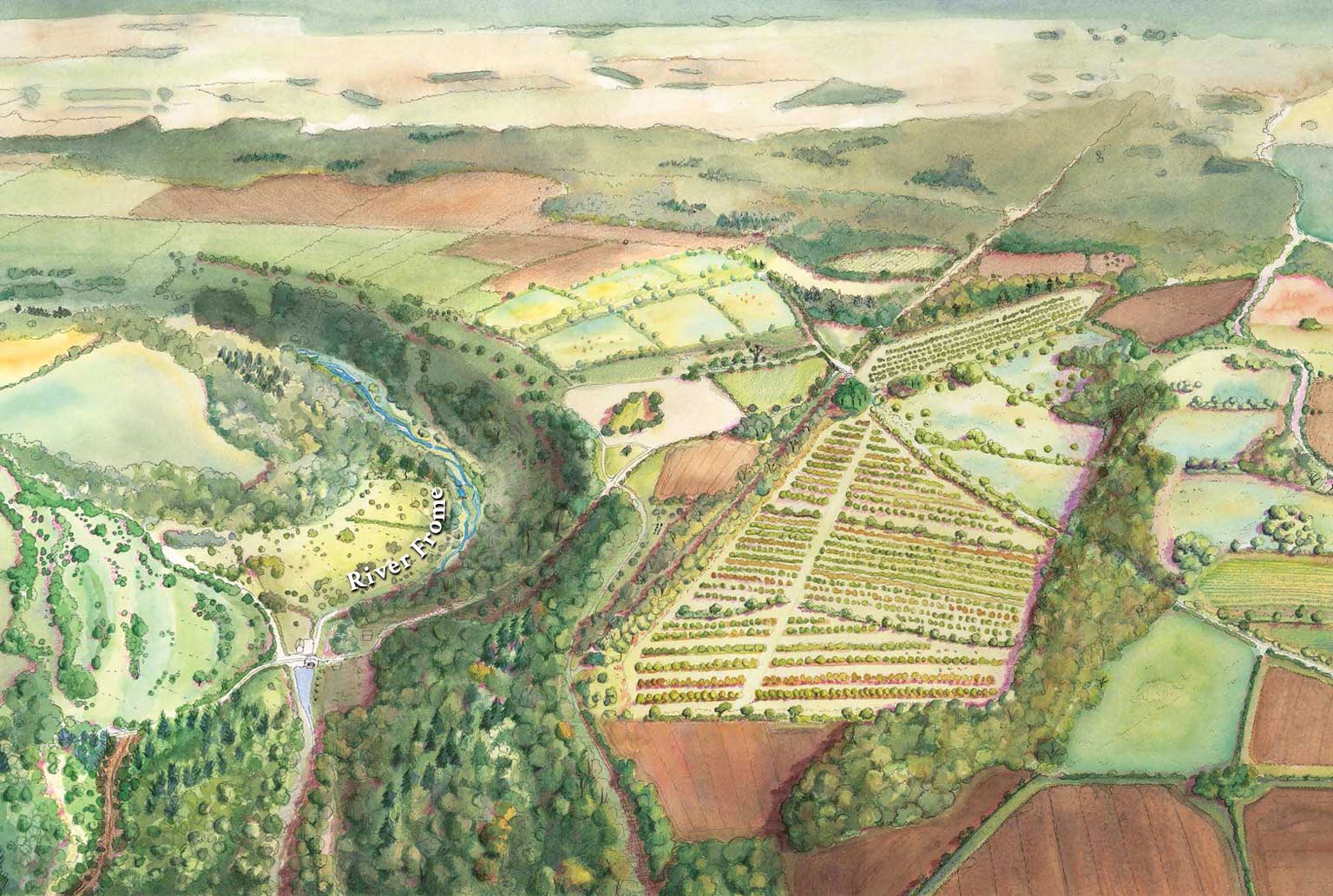
Water Cycle
During the first decades of this century flooding and drought became more frequent. The cause was a combination of habitat loss, intensive agriculture and changes to precipitation rates caused by climate change. The Government adopted policies that paid farmers to provide ecosystem services to help prevent flooding and the impacts of drought. Actions taken at Sapperton Wilder have resulted in a healthier hydrology;
- Using the five principles of soil regeneration has significantly improved the soil structure and consequently water infiltration rate and water storage capacity, this reduces water runoff, reducing flooding and increases the amount of water available in the soil during times of low precipitation.
- Thousands of new trees and shrubs and now reaching maturity, their roots and associated mycorrhizal fungal network help maintain soil moisture levels by moving water up and down through different depths of the soil, benefiting the whole farm ecosystem.
- In February 2025 the Government made the historic announcement that beavers could be released into the wild. Beavers were re-introduced into the upper Frome valley in the late 2020’s and have now created dynamic wetland with dams and pools, causing the river channel to divide and spread out over the valley bottom. Wildlife is abundant, including the reintroduced pool frog. Beaver dams slow down the rate of flow and store water during storm events helping to prevent flooding downstream. Beavers only graze and browse within 20m of the water course. Local beaver wardens regularly monitor the wetlands and report any issues which are managed through installation of beaver fences, tree guards and pipes in their dams which reduce the height of water in the pools.
